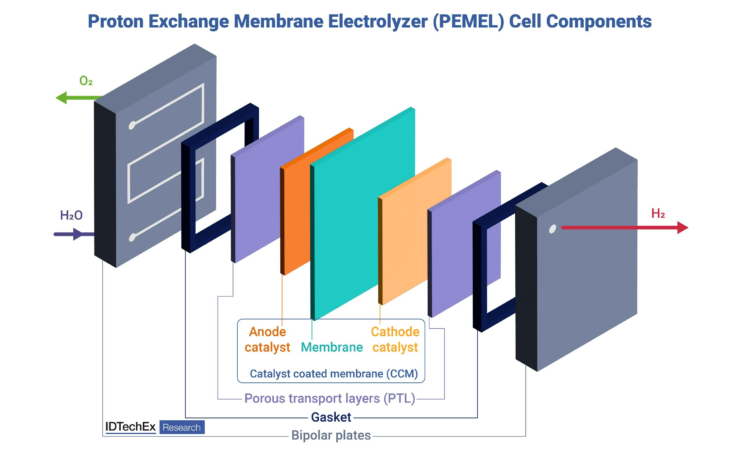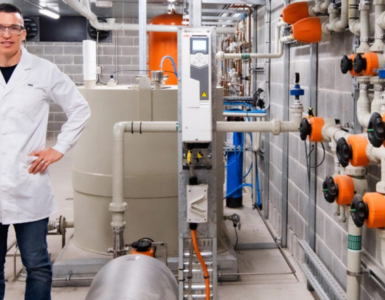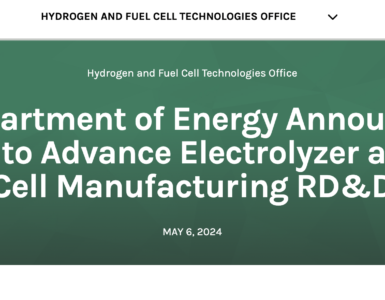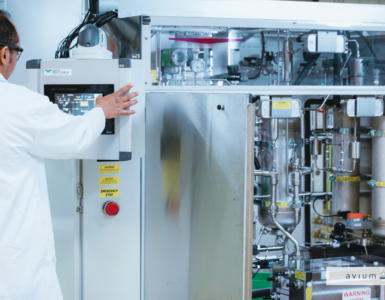IDTechEx Forecasts Material Innovation to Drive the Water Electrolyzer Market.
In an era marked by a global shift towards sustainable energy solutions, the hydrogen industry is at the forefront of this transformative wave. Green hydrogen, produced through water electrolysis-powered renewable energy, stands out as a key solution for decarbonizing sectors where direct electrification remains a challenge. This pivot is an essential step towards reducing emissions in heavy industries, such as petroleum refining, and transportation sectors like maritime shipping. Governments and companies worldwide are now setting ambitious targets to ramp up green hydrogen production, highlighting its potential to enhance energy security and unlock new market opportunities.
At the core of the green hydrogen surge is the continuous innovation in electrolyzer technology. Electrolyzers, the devices responsible for splitting water into hydrogen and oxygen, rely heavily on advanced materials for their electrodes, membranes, and catalysts. These components are critical for optimizing efficiency, durability, and overall performance. Innovations in material science, such as the development of more robust membranes or efficient catalysts, play a pivotal role in reducing costs, increasing lifespan, and minimizing the use of rare, expensive materials. As the demand for green hydrogen escalates, the progress in material technology becomes ever more crucial. However, it is not just about creating more effective electrolyzers. It also ensures these systems are sustainable, scalable, and accessible to pave the way for a truly green hydrogen economy.
IDTechEx’s new report, “Materials for Green Hydrogen Production 2024-2034: Technologies, Players, Forecasts“, delves into the current and prospective materials and components utilized in the four main water electrolyzer technologies. It also covers production methods, commercial activities, key industry players, and major innovations across all electrolyzer stack components.
🔥 What about we co-host a webinar? Let's educate, captivate, and convert the hydrogen economy!
Hydrogen Central is the global go-to online magazine for the hydrogen economy, we can help you host impactful webinars that become a global reference on your topic and are an evergreen source of leads. Click here to request more details
Alkaline water electrolyzer (AWE): Innovation with widely available materials
Alkaline water electrolyzers, a time-tested and robust technology, function using a liquid alkaline solution, usually KOH, and a porous diaphragm to separate the half-cell chambers. Their reliance on readily available materials, such as nickel and stainless steel, is a trend expected to continue. Presently, AWE systems are categorized into finite-gap and zero-gap configurations, with the industry increasingly favoring the latter. This preference is due to the inclusion of porous transport layers (PTLs), which significantly boost efficiency and gas transport properties.
Innovation remains a driving force in the realm of AWE systems, with manufacturers exploring new frontiers in electrode coatings and catalysts. These advancements aim to enhance the efficiency and effectiveness of this established technology. Additionally, there is a growing focus on refining stack designs to facilitate more responsive gas evolution. Such innovations are crucial for enabling better integration with renewable energy sources and optimizing green hydrogen production. While many companies have started producing stacks internally, the dependency on external suppliers for several components continues. This interdependence presents opportunities for further innovation, particularly in advancing catalysts and evolving cell configurations to enhance the capabilities of AWE systems.
Proton exchange membrane electrolyzers (PEMEL): Advancing efficiency with reduced precious metal use
Infographic – https://mma.prnewswire.com/media/2285884/IDTechEx_Infographic.jpg
Proton exchange membrane electrolyzers (PEMEL) are gaining significant traction for their high efficiency, compact design, and adaptability with fluctuating renewable energy sources. While there is a movement towards standardizing materials in PEMEL stacks, innovation is far from stagnant, particularly in anode catalyst development. Recent breakthroughs include catalysts that maintain high catalytic activity while significantly reducing iridium usage, thus lowering the material cost per kilowatt (kW) and enhancing overall affordability. More importantly, the adoption of such innovations is critical to the success of PEMEL, as there are many concerns that its potential will be limited by future iridium supply.
Other innovations within PEMEL technology are diverse and impactful. For instance, advancements in thinning the proton exchange membranes contribute to improved efficiency, while innovative coatings for titanium bipolar plates enhance durability and reduce reliance on precious metals. These developments, along with advanced commercial PEMEL designs, underscore the potential for significant improvements in stack performance. Novel coatings and manufacturing methods, particularly for the catalyst-coated membrane (CCM), are at the forefront of these enhancements, promising a new era of cost-effective and efficient PEMEL technology.
Anion exchange membrane electrolyzers (AEMEL): Merging the benefits of AWE and PEMEL
The anion exchange membrane electrolyzer (AEMEL) is a growing technology that aims to harness the best of both alkaline and PEM technologies. AEMEL seeks to blend the material abundance of the AWE with the high-efficiency characteristic of the PEMEL. This technology is experiencing rapid growth and innovation, exemplified by companies like Enapter, which are pioneering commercial megawatt-scale systems.
Being a relatively young technology, the materials are not as standardized as in AWE and PEMEL. Therefore, there is significant potential for innovation with AEMEL, with academic and commercial research concentrated on advancing membranes and catalysts within the technology. This aspect not only fuels its innovation potential but also strategically places AEMEL to potentially revolutionize the landscape of electrolyzer technologies with its unique potential blend of stability, efficiency, and material accessibility.
Solid oxide electrolyzer cells (SOEC): Ceramic innovation at high temperatures
Solid oxide electrolyzer cells (SOEC) represent a relatively nascent technology in the electrolysis landscape, with a smaller market presence compared to AWE and PEMEL. However, SOEC is gaining significant momentum through shared innovations with the solid oxide fuel cell (SOFC) sector. The interchangeability between SOFC and SOEC stacks, particularly in their use of similar materials, is a key advantage. While certain ceramic components have already been established in the technology, the development of new electrode-electrolyte assemblies in SOECs remains a dynamic area of innovation. This includes considerable variations in cell design and material use among different stack manufacturers. These range from metal- to electrode-supported types, each having its own advantages and incorporating a variety of ceramic materials.
One of the key challenges in SOEC is the thermal compatibility of different materials. This has caused advancement in the other stack components, such as interconnects and sealants. New materials and coatings improve thermal compatibility as well as reduce degradation of the cell components. Overall, there is a wide range of materials used in SOEC stacks, which not only underscores the diversity in the technology but also emphasizes the potential for material innovation in these high-temperature electrolyzers. The evolving landscape of SOEC presents exciting possibilities for advancing electrolysis technology through novel ceramic materials and innovative cell configurations.
Market outlook & strategic insights
The electrolyzer component market is poised for significant expansion, with IDTechEx’s projections estimating its market value to reach an impressive US$31.7 billion by 2034. This growth is predominantly driven by the rapidly evolving green hydrogen industry, where electrolyzers play a crucial role. In the new report “Materials for Green Hydrogen Production 2024-2034: Technologies, Players, Forecasts” by IDTechEx, a thorough analysis is presented on the current and future materials and components used in the four principal water electrolyzer technologies: alkaline water electrolyzer (AWE), proton exchange membrane electrolyzer (PEMEL), anion exchange membrane electrolyzer (AEMEL), and solid oxide electrolyzer (SOEC).
The report offers an insightful breakdown of stack costs by component, focusing on AWE, PEMEL, and SOEC stacks. Comprehensive lists of electrolyzer stack, component, and material suppliers are available, with case studies of key commercial innovations in the industry. Moreover, it provides granular 10-year market forecasts, quantifying the demand for materials and components in tonnes, square meters (m2), and US$ million annually. This report provides a deep insight into the current trends and prospects of the electrolyzer market, highlighting key opportunities and the direction of industry growth.
READ the latest news shaping the hydrogen market at Hydrogen Central
IDTechEx Forecasts Material Innovation to Drive the Water Electrolyzer Market. source








